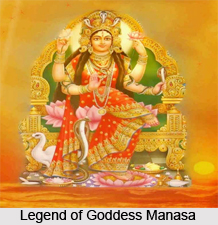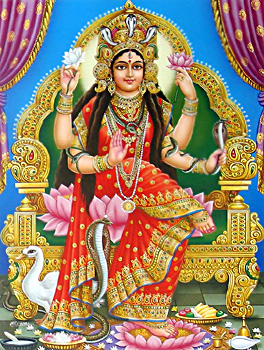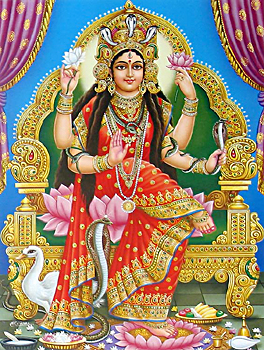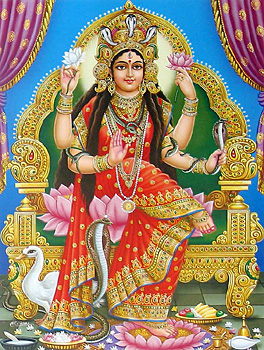Introduction
 Manasa is famous as the goddess of serpents, very powerful and worshipped in different forms and with different names throughout India. The goddess is worshipped mainly during the rainy season, when the snakes are most active. There is a belief that Manasa protects the people from snake bite. Goddess Manasa is also linked with fertility and worshipped for the revival and protection from several incurable diseases. She can be worshipped in the form of an idol or even as a formless power. She is known as the daughter of famous sage Kashyapa and Kadru, the sister of serpent king Sesha and also the sister of Vasuki, one of the most important Nagas. Manasa is known to be a pre-Aryan goddess who is most commonly worshipped in different parts of West Bengal. She is ritually invoked with sacrifices and offerings. The tale of Manasa is called `Manasamangal` where the story of her gaining recognition and attainment a place among the Hindu pantheon of gods and goddesses are depicted. She is also the name of a form of Lord Vishnu born out of Sambhuti, along with the gods Abhutarajasas in the Rawala Manwantara.
Manasa is famous as the goddess of serpents, very powerful and worshipped in different forms and with different names throughout India. The goddess is worshipped mainly during the rainy season, when the snakes are most active. There is a belief that Manasa protects the people from snake bite. Goddess Manasa is also linked with fertility and worshipped for the revival and protection from several incurable diseases. She can be worshipped in the form of an idol or even as a formless power. She is known as the daughter of famous sage Kashyapa and Kadru, the sister of serpent king Sesha and also the sister of Vasuki, one of the most important Nagas. Manasa is known to be a pre-Aryan goddess who is most commonly worshipped in different parts of West Bengal. She is ritually invoked with sacrifices and offerings. The tale of Manasa is called `Manasamangal` where the story of her gaining recognition and attainment a place among the Hindu pantheon of gods and goddesses are depicted. She is also the name of a form of Lord Vishnu born out of Sambhuti, along with the gods Abhutarajasas in the Rawala Manwantara.
Manasa the mythological deity of the serpents are worshipped for the prevention and cure of snakebite and also for fertility and opulence. In the Puranas, Manasa is featured as the sister of Vasuki, king of Nagas. She is the wife of great sage Jagatkaru. Manasa is also known as the Vishahara, the demolisher of poison.
Origin of Manasa Devi
Manasa Devi is known as the daughter of famous Sage Kashyapa and Kadru. She is the sister of serpent king Sesha and Vasuki, one of the most important Nagas. Manasa is known to be a pre-Aryan Goddess who is most commonly worshipped in different parts of Bengal. She is ritually invoked with sacrifices and offerings. She is also the name of a form of Vishnu born out of Sambhuti, along with the Gods Abhutarajasas in the Rawala Manwantara.
Legend of Manasa Devi
Manasa Devi was the daughter of Lord Shiva by a beautiful mortal woman. She was not liked by her step-mother, Parvati; so she took up her abode on earth with another daughter of Shiva, named Neta. Due to the confusion in her parentage, Goddess Manasa was never really elevated to the status of a premium deity.
Manasa wished to receive the worship as a Goddess and knew that it would be easy to obtain the same if she could once secure the devotion of a very wealthy and powerful merchant-prince of Champak Nagar, by the name of Chand Saudagar in Bengal. He was a widower and had six sons. He was very attentive to his sons so that they never felt the absence of their mother. For a long time, she tried to persuade him; but he was a stout devotee of Shiva himself, whom he was not going to desert for a Goddess of snakes. Manasa thus destroyed the beautiful garden of Chand many times and every time Chand used to restore the beauty to his garden by the help of his magic power, which he had received from Shiva.
Once Manasa took the guise of a beautiful maiden and appeared before the widower Chand, who was enchanted by her beauty. He decided to marry her but the lady asked for the magic powers of Chand to be bestowed on her before the marriage and Chand did the same. Then Manasa showed her original self and again told Chand to worship her but that time also Chand rejected her demand. Then six of the sons of Chand were killed by snake bites with the instructions of Manasa and Chand remarried and got a son and named him Lakhindar. Lakhindar grew up to be a handsome young lad and Chand selected a beautiful girl named Behula to be married with him. The couple was engaged and wedding date was fixed. In those years Manasa did not give up her hope and appeared again with her resolve to subdue Chand by killing Lakhindar.
Manasa killed Lakhindar and due to the love and devotion of Behula, Lakhindar was brought back to life. Finally, Behula convinced her father-in-law to worship the Manasa Devi and thus Chand agreed and promised to worship Manasa by using his left hand to perform the rites. This was accepted by Manasa and Chand worshipped Manasa with all his devotion. Thus this legend of Goddess Manasa gave Manasa Devi much reputation and people worshipped her in all parts of India.
 Legend of Goddess Manasa has been connected to the life of a rich merchant named Chand Saudagar who lived in Bengal. Goddess Manasa was the daughter of Shiva by a beautiful mortal woman. She was not a favourite of her step-mother, Bhagavati, or Parvati, and therefore she took up her abode on earth with another daughter of Shiva, named Neta. The daughter of Shiva liked to be worshipped by human beings as other gods and goddesses and she knew that her desire would be fulfilled if she could once secure the devotion of a very wealthy and powerful merchant-prince of Champaka Nagar, by the name of Chand Saudagar. She laboured for long to persuade Chand to worship her, but he was a stout devotee of Shiva and he would not desert his lord for a goddess of the snakes. Since Manasa Devi was a goddess and queen of serpents.
Legend of Goddess Manasa has been connected to the life of a rich merchant named Chand Saudagar who lived in Bengal. Goddess Manasa was the daughter of Shiva by a beautiful mortal woman. She was not a favourite of her step-mother, Bhagavati, or Parvati, and therefore she took up her abode on earth with another daughter of Shiva, named Neta. The daughter of Shiva liked to be worshipped by human beings as other gods and goddesses and she knew that her desire would be fulfilled if she could once secure the devotion of a very wealthy and powerful merchant-prince of Champaka Nagar, by the name of Chand Saudagar. She laboured for long to persuade Chand to worship her, but he was a stout devotee of Shiva and he would not desert his lord for a goddess of the snakes. Since Manasa Devi was a goddess and queen of serpents.
Manasa Destroys the Garden of Chand
Chand Saudagar was a widower and he had six sons. He made a beautiful garden on the outskirts of the city, an earthly paradise, where he used to eat the air and enjoy the flowers every evening. Manasa send her snakes to reduce the garden to ashes, but as Chand had received from Lord Shiva the magic power of restoring the dead to life, he thus restored the garden to all its beauty by merely uttering the appropriate charms. Then Manasa appeared to Chand in the form of a beautiful girl, so silvery and radiant that even the moon hid her behind the clouds when she saw her. He fell madly in love with her, but she would not hear a word till he promised to bestow his magic power upon her; and when he did so, she vanished away and appeared in the sky in her own form, and told to Chand to worship her. But then also Chand did not obey her words. Then she destroyed the garden again and Chand sent for his friend Shankara, a great magician, who very soon revived the flowers and trees and made the garden as good as before. However, Sankara was killed by Manasa, and then she again destroyed the garden a third time; and then there was no remedy.
Manasa Kills the Six Sons of Chand
After destroying the garden of Chand for the third time, Manasa was not able to make Chand worship her. Thus enraged by anger, she sent her serpents to kill every one of his six sons, and at the death of each she whispered the same message in the ear of Chand by telling him to worship her, and everything would be well. Chand was an obstinate man, and sad as he was, he would not give in. On the contrary, he fitted out his ships for a trading voyage and set forth. He was very successful, and was nearing home, with a load of treasure and goods, when a storm fell on the ships. Chand prayed to Parvati, the wife of Shiva, and she protected his ship. Manasa, however, represented to her father regarding her mother`s interference in her matter and Shiva persuaded his wife to return to Heaven with him.
Bhagavati then left with Shiva for the heaven and the boat sank, and Chand was left in the sea. Manasa did not intend to kill Chand and therefore cast her lotus throne into the water. Since Padma or Lotus was another name of Manasa, Chand, even after seeing the floating object by which he was going to save himself was actually a padma he left it alone, preferring drowning to receiving any help from a thing bearing the hated name of his enemy. However, Chand was brought to the shore by Manasa. He came to the city where his old friend, Chandraketu, had his home. He was kindly treated there, and began to recover a little; but when he discovered that Chandraketu was a devotee of Manasa, and that her temple adjoined the house, he departed the place, throwing away even the garments his friend had bestowed upon him.
After leaving the home of his friend, Chand begged some food, and going down to the river, took his bath. While he was bathing Manasa sent a large mouse, which ate up his rice, and he had nothing to eat but some raw plantain-skins left by some children on the river-bank. Then he worked as a servant in a Brahmin family as a reaper and thresher; but Manasa turned his head so that he worked quite stupidly, and was rejected by the Brahmin. Lastly, he returned to Champak Nagar, and he hated Manasa Devi more than ever.
Lakshmindara, Son of Chand
Manasa Devi had two great friends, apsaras in the heaven of Indra. They made up their minds to win over the obstinate merchant and one of them was born as Chand`s son, the other as the daughter of Saha, a merchant of Nichhani Nagar and an acquaintance of Chand. The son of Chand was named Lakshmindara and when he grew up to be married, He got married to beautiful Behula, the daughter of Saha. Just before the marriage, the astrologers predicted that Lakshmindara would die of the bite of a snake on the night of his marriage. Chand ordered for the construction of a steel house, taking care that there were no cracks in it large enough for even a pin to enter. The house was guarded by sentinels with drawn swords; mongooses and peacocks were let loose in the park around it. But Manasa appeared to the craftsman and threatened to kill himself and all his family if he would not make a tiny hole in the steel wall. He was very unwilling to do it, and at last he gave in from sheer fright, and made a hole the size of a hair, hiding the opening with a little powdered charcoal. Thus, through that hole, one of the snakes sent by Manasa Devi entered inside the steel house and killed Lakshmindara.
Lakshmindara Killed by Manasa
The next morning, Lakshmindara was found dead by his mother and preparations were made to set afloat the dead body on a raft, in the hope, perhaps, that some skilful physician or snake-charmer might find the body and restore it to life. But when the raft was ready Behula sat down beside the body and despite the attempt of all, she promised not to leave it till the body was restored to life. Behula floated away with the dead body of her husband, and very soon Champaka Nagar was out of sight. She met with various hardships in her way but was saved by her love and devotion towards her husband and prayed all day to Manasa Devi, and though she did not restore the body to life, still the goddess protected it from storms and crocodiles, and sustained Behula with strength and courage. At last, after six months, the raft touched ground just where Manasa`s friend Neta lived by the river-side.
Life Bestowed on Lakshmindara by Manasa
Neta was washing clothes, but Behula could see by the glory about her head that she was no mortal woman. A beautiful little boy was playing near her and spoiling all her work; suddenly she caught hold of the child and strangled him, and laid the body down beside her and went on with her work. But when the sun set and her work were done, she sprinkled a few drops of water over him, and he woke up and smiled as if he had just been to sleep. Then Behula landed and fell at the washerwoman`s feet. Neta carried her up to Heaven to see if the gods might be moved to grant her prayer. The gods asked Behula to dance, and she pleased them so much that they promised her to bring her husband back to life and to restore all the losses of Chand. But Manasa Devi did not agree to this until Behula undertook to convert her father-in-law and persuade him to honour and worship the goddess and Behula promised to do the same, and then Lakshmindara was granted life.
Behula and Lakshmindara went home and after a long time they came to her father`s home and they stopped to visit her father and mother. But they did not stay, and set out the same day for Champaka Nagar. The first people she saw were her own sisters-in-law, who had come to the river-bank to fetch water. She had disguised herself as a poor sweeper, and she had in her hand a beautiful fan on which she had the likeness of every one in the Chand family depicted. She showed the fan to the sisters, and told them her name was Behula, a sweeper-girl, daughter of Saha, a sweeper, and wife of Lakshmindara, son of the sweeper Chand. The sisters ran home to show the fan. Sanaka was very much surprised, but she thought of the lamp in the steel house, and when she ran to the bridal-chamber the door was shut tight for a year. Then she ran on to the river-side, and there was her son with Behula. She told that until her father-in-law agrees to worship Manasa Devi, they would not visit their home.
Chand Saudagar was not able to resist any longer and accepted the might of Manasa Devi. He worshipped her on the eleventh day of the waning moon in the very same month. It is true that he offered flowers with his left hand, and turned away his face from the image of Manasa; but, for all that, she was satisfied, and bestowed on him wealth and prosperity and happiness, and she restored his friend Shankara to life. Ever since then Manasa Devi`s claim to the worship of mortals has been freely admitted.
Iconography Of Manasa
 The cult of Manasa or the snake goddess is very common in the state of West Bengal in India. The cult of Manasa was most popular during the 15th century and the traces of such popularity can be known from the Manasa Mangal. Sometimes the origin of Manasa is dated back to the Vedic or Puranic traditions and sometimes the goddess is even identified with the Vedic Saraswati.
The cult of Manasa or the snake goddess is very common in the state of West Bengal in India. The cult of Manasa was most popular during the 15th century and the traces of such popularity can be known from the Manasa Mangal. Sometimes the origin of Manasa is dated back to the Vedic or Puranic traditions and sometimes the goddess is even identified with the Vedic Saraswati.
The iconographical study of the Manasa image suggests that her image is made of black basalt. The seven-hooded and two-armed goddess is shown seated in lalitasana on a double-petalled lotus placed over a jar from which two snakes are seen coming out. She is shown wearing various ornaments among which are very popular the sarpa-kuchabandha which is actually a breast band made of snakes. At the same time the deity is represented holding an eight hooded snake in her left hand. Her right hand is in the varada position holds a fruit. She is attended on either side by a seated emaciated figure and a crowned male person identified with Jaratkaru and Astika which is actually her husband and son respectively according to the epic and Puranic tradition.
The jar on the pedestal is flanked on one side by a pot with a heap of naivedya and on other side the deity is a female devotee with folded hands.
In another iconography instead of a Krittimukha with a flying Naga on either side on the pointed stele there is a floral design. In this iconography the images of the goddess made of sandstone. Another image of the deity is thoroughly abbraised. The stele is elliptical in shape. There is sparing use of ornamentation on the body of the image. Goddess Manasa is sometimes called the one-eyed goddess because on of her eyes was burnt by her step-mother.
Worship of Manasa Devi
Manasa Devi is an extremely furious Goddess for those who refuse to worship Her, while extremely kind to those who worship Her with devotion. She is considered to be very powerful and worshipped in different forms and with different names throughout India. The Goddess is worshipped mainly during the rainy season, when the snakes are most active. She can be worshipped in the form of an idol or even as a formless power.
Food Offerings to Goddess Manasa
 Food offerings to Goddess Manasa are an example of the survival of ancient traditions, namely, custom of appeasement. Elaborate rituals are performed in honour of Manasa, the Hindu snake Goddess, in the second month of the rainy season. In Bengal, as in many other parts of India, snakes tended to infest the waterlogged rice fields and densely vegetated areas. One bite from a poisonous species such as the Indian cobra and the Indian krait could cause instant death. As a result of this, the villagers used to throw themselves on the mercy of the snake Goddess, make offerings to her and pray for survival as they went about their necessary agricultural tasks. So great was the fear of snakes and so ingrained was the belief that feeding the creatures (as surrogates of the goddess) could ensure life and safety, that many rural households made a habit of leaving a bowl of milk out for the snake to consume on certain auspicious days of the year.
Food offerings to Goddess Manasa are an example of the survival of ancient traditions, namely, custom of appeasement. Elaborate rituals are performed in honour of Manasa, the Hindu snake Goddess, in the second month of the rainy season. In Bengal, as in many other parts of India, snakes tended to infest the waterlogged rice fields and densely vegetated areas. One bite from a poisonous species such as the Indian cobra and the Indian krait could cause instant death. As a result of this, the villagers used to throw themselves on the mercy of the snake Goddess, make offerings to her and pray for survival as they went about their necessary agricultural tasks. So great was the fear of snakes and so ingrained was the belief that feeding the creatures (as surrogates of the goddess) could ensure life and safety, that many rural households made a habit of leaving a bowl of milk out for the snake to consume on certain auspicious days of the year.
The biological fact that snakes only eat rodents and other live creatures that they hunt had no effect on the persistent belief in the efficacy of the milk. In a peculiar concurrence, when a particular snake happened to make its nest near a house and yet, over time, none of the family was bitten, the popular psyche transformed the object of terror almost into a household creature. It was referred to as a vastu shaap, or resident snake, and a nightly ration of milk was left out for it with as much punctiliousness as if it was a pet cat.
The enormous mangrove forests of the Sunderbans area of Bengal are the domain of the fearsome Bengal tigers that often hunt man as prey, unlike tigers in other parts of India. The locals, who depend on harvesting honey from the forest areas, have no option but to risk their lives as they venture ashore. Over time, however, they have endowed both the tiger and the forest itself with mythical dimensions embodied in the legend of Bon Bibi (forest goddess) and Dakkhin Rai (the tiger as god). In the story, an unscrupulous merchant propitiates the evil Dakkhin Rai by abandoning a young man called Dukhey who was a member of his ship`s crew. The tiger god would feast on Dukhey and, in return, let the merchant conduct his business without interference. Dukhey is rescued from the tiger`s grasp because of his heartfelt prayers to Bon Bibi and her brother who magically transport him to a safe location. The underlying belief, however, is that if a powerful predator like the tiger can be appeased with a satisfying meal (in this case, a designated human being), he may permit people to earn their livelihood.
Thus, the concept of appeasement of Gods and Goddesses in order not to incur their wrath is the reason behind offering food as appeasement to Goddess Manasa.




















